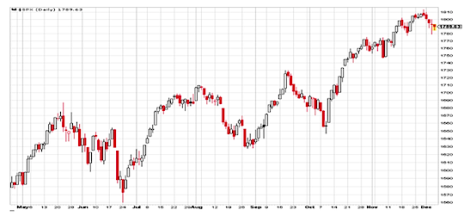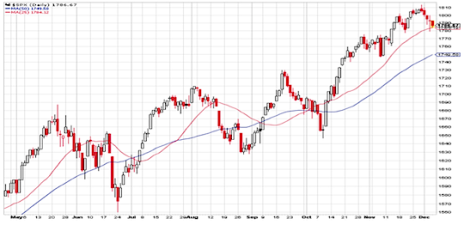Stock Market Video
How Market Timing Really Works
This Week’s Fortune Cookie
In Case You Missed It ---
--- Advertisement ---
10 Year-End Trades Every Investor Should Make Now
All of these are riding the trends in their own sectors higher and match trading signals that led us to 386% gains in Tesla, 191% gains Qihoo, 93% gains in Green Mountain Coffee Roasters, and 93% gains in First Solar.
Now is the perfect time to test-drive our market-beating service before the end of the year.
For more details, click here now.
---
In this week’s Stock Market Video, Mike Cintolo says nothing has officially changed with his outlook, but under the market’s hood, he’s seeing a small shift toward growth stocks after two months of lagging action. It’s not enough of a signal to pile in, but he points out many buyable (or soon-to-be-buyable) charts among growth stocks, including some new leaders. Click below to watch the video!
How Market Timing Really Works
Cabot China & Emerging Markets Report uses market timing. So does Cabot Market Letter. And we’re good at it. Market timing keeps us in step with the market.
But I just read a piece by Mitch Zacks, Senior Portfolio Manager for the Zacks Funds and the firm’s “primary expert on quantitative investing,” titled 3 Common Investing Mistakes.
And mistake number two was market timing.
To quote the article, “Being able to time the market consistently and accurately is the hold grail of investing. No one, in the history of the stock market, has been able to do this.”
So how is it that one of Cabot’s proudest achievements is something so difficult that no one has ever been able to do it?
I’m glad you asked.
When Mr. Zacks, and every other investment professional in the world talks about market timing, they’re talking about predicting the behavior of the stock market. As the next sentence in his article says, “Timing the market means being able to forecast dips, corrections and bear markets and move assets out of stocks as these events occur.” And, he adds, you also have to get it exactly right when you get back in, as well.
So there’s the problem. Zacks says that you can’t predict the future. And he’s right. I mean, just look at this chart. See that big two-day dip on June 19 and 20. And how about that big reversal to the upside on October 10? Totally out of the blue. Impossible!
But there are two assumptions behind Mr. Zacks observations that make it irrelevant to the market timing that Cabot (successfully) does. First, he assumes that we’re trying to anticipate what will happen tomorrow. Second, he takes it for granted that market timers are placing their bets using a broad market index fund based on the S&P 500 or the Dow. So what happens if you’re not trying to anticipate the market?
And what happens if you’re buying individual stocks?
Here’s the same chart as the one shown above, but with the 25- and 50-day moving averages included.
Now, suppose that you had exited the market every time the S&P dropped below both of those moving averages (this has happened three times in the past six months, in June, August and October). And that you had re-entered the market when the market got back above the lower of the two averages. You would have eliminated some of the downside risk and captured some of the upside opportunity.
But Cabot’s market timing approach isn’t quite that simple minded. We (the Market Letter and the China & Emerging Markets Report) advise on buying individual stocks, not index funds. And we use our market timing as a way to control the risk of buying, selling and holding these often-volatile stocks. When the indexes we use have fallen below their 25- and 50-day moving averages, we let our subscribers know that our market timing signal is now flashing a caution light. We advise a cutback in buying and a tightening of maximum loss limits on current holdings. Individual stocks are still handled as individuals! If a stock ignores the market’s action and keeps on climbing, we let it climb. But if a stock comes under selling pressure, a negative signal from our timing indicators will cause us to exercise more caution and sell a little more quickly.
The purpose of Cabot’s market timing indicators is to get us in step with the market. A bull market improves the odds of finding the two or three growth stocks that will make your investing year a successful one. And a bear market makes it harder for stocks to fight against the current.
By giving a decisive signal, the Cabot market timing signals let us know how the market is doing. And even when, as has happened three times in the last six months, we get three warning signals followed by rebounds, we’re neither impatient nor disappointed. We have advised people to hold or sell based on the charts of their individual stocks, so no damage was done.
Besides, it’s the markets big moves that make the real difference in your portfolio’s results. Everyone who was in the market remembers what happened around 2008. The S&P plummeted and tumbled from 1560 in October 2007 to 667 in March 2009. It was an ugly, awful time.
What most people don’t realize is that Cabot Market Letter, using our market timing indicators, was mostly out of the market for much of that time. The Market Letter averaged 50% cash during the entire bear market and was 90% in cash when Lehman went belly up. I took Cabot China & Emerging Markets Report completely out of the market for months. We were 100% in cash!
The market turned up in March 2009, and my letter made its first buy on April 2. With the confidence that a meaningful signal gives, I got my subscribers back into the market while many investors were still in shock.
So, the next time you read someone warning you that you can’t time the market, remind yourself that you don’t have to play their game. All the Ouija boards and crystal balls in the world won’t tell you what the market will do tomorrow. But Cabot’s market timing indicators will do something even more valuable. They’ll tell you what’s happening right now! And that’s the most important piece of information a growth investor can have.
---
And just by-the-way, Cabot will be coming out soon with our annual report on stocks with low prices and high potentials. It’s called Cabot’s 10 Favorite Low-Priced Stocks for 2014, and it’s written by Mike Cintolo, the savviest of our growth gurus. It includes 10 stocks, all trading under 10, that have plenty of upside for early 2014. Mike gives fundamental analysis for each stock and a technical analysis of its chart. These stocks are selected for their short-term appreciation potential, and have produced great winners in past years. You can get a deal by ordering before December 15.
Click here for the necessaries.
---
Here’s this week’s Fortune Cookie. Remember, you can always view all previous Fortune Cookies here and Contrary Opinion buttons here.
Tim’s Comment: As the head of Cabot, I plead guilt to optimism that appears at time to be unfounded. But as an investor, and as an observer of investor sentiment, I am deeply aware that the very best time for optimism is when all the world is pessimistic, and conversely, that when everyone else is optimistic, I should be pessimistic (about the market.)
Paul’s Comment: It’s hard to take the leap to start (or even run) a business if you’re not convinced at a deep level that the future is going to get better. (For some people, this is confidence in themselves, not in the future, but let that pass.) I think it’s also hard to be a growth investor if you don’t have a basically hopeful outlook. Pessimists prepare for the worst, and get grumpy when they don’t get it. Optimists are invested for good times, and over the years, that’s what the market has delivered.
---
In case you didn’t get a chance to read all the issues of Cabot Wealth Advisory this week and want to catch up on any investing and stock tips you might have missed, there are links below to each issue.
Cabot Wealth Advisory 12/2/13—Lincoln: The Man, The City, The Car
Taking up a subscriber’s challenge, Tim Lutts of Cabot Stock of the Month writes about all three Lincolns. Tim also sounds a little warning that the current stock market rally is getting a little gray around the temples. Stock discussed: Gogo (GOGO).
Cabot Wealth Advisory 12/5/13—Simplicity Is the Ultimate Sophistication
Mike Cintolo, the man behind Cabot Market Letter, writes about the need for simplicity in investing rules and warns about the dangers that come after a long bull market. It’s time to stay focused on proven rules. Stock discussed: U.S. Silica (SLCA).
Have a great weekend,
Paul Goodwin
Editor of Cabot Wealth Advisory
Chief Analyst of Cabot China & Emerging Markets Report
P.S. I’m going to be presenting a program on China at the World MoneyShow in Orlando, Florida on January 30, just before dinnertime. The World MoneyShow is a major gathering of investors of every stripe, including gold bugs, day traders, dividend investors, growth investors and vendors of every kind of investment software and service imaginable. The conference kicks off January 29 and ends on January 31. If you need an excuse to go to Orlando to build up your strength to get through February, I’m glad to provide it. I hope to see you there.



